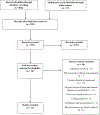Physical activity and fitness in childhood cancer survivors: a scoping review
- PMID: 35098147
- PMCID: PMC8794406
- DOI: 10.1002/aac2.12042
Physical activity and fitness in childhood cancer survivors: a scoping review
Abstract
Background: Estimates indicate that nearly eight percent of the over 500,000 survivors of childhood cancer living in the United States are frail in their fourth and fifth decades of life, a phenotype typically seen in geriatric populations. Participation in regular physical activity to improve physical fitness in healthy and diseased populations reduces risk for frail health by increasing physiologic reserve. However, physical activity may not have the same effects on fitness in childhood cancer survivors as it does among their peers with no cancer history.
Aims: This scoping review seeks to describe associations between physical activity, physical fitness, chronic disease, and mortality in childhood cancer survivors.
Methods: Relevant literature was identified through a comprehensive search in the PubMed, Web of Science, CINAHL, and Cochrane databases. A narrative synthesis was performed on observational studies that had physical activity or physical fitness clearly defined and compared with chronic disease outcomes.
Results: A total of 595 studies were screened, and results from 11 studies are presented. Childhood cancer survivors who participate in regular physical activity have improved markers of cardiovascular health, decreased risk of overt cardiovascular disease, and decreased risk of all-cause mortality compared to survivors who are not physically active. Childhood cancer survivors who are physically fit have increased neurocognition, and decreased risk of all-cause mortality compared to survivor's who are not fit. The differential effects of physical activity on fitness and health among childhood cancer survivors when compared to peers is potentially related to treatment exposures that damage cardiovascular tissue and impact regenerative potential.
Conclusion: Research is needed to determine the optimal timing, frequency, intensity, and duration of physical activity necessary to optimize fitness in childhood cancer survivors.
Keywords: chronic disease; physical activity; physical fitness; survivorship.
Conflict of interest statement
Conflict of interest The authors have stated explicitly that there are no conflicts of interest in connection with this article.
Figures



References
-
- Howlader N, Noone AM, Krapcho M, Miller D, Bishop K, Kosary CL, Yu M, Ruhl J, Tatalovich Z, Mariotto A, Lewis DR, Chen HS, Feuer EJ, Cronin KA (eds). SEER Cancer Statistics Review, 1975–2014, National Cancer Institute. Bethesda, MD, https://seer.cancer.gov/csr/1975_2014/, based on November 2016 SEER data submission, posted to the SEER web site, April 2017.
-
- Oeffinger KC, Mertens AC, Sklar CA, et al. Chronic health conditions in adult survivors of childhood cancer. NEJM. 2006;355(15):1572–1582. - PubMed
-
- Collard RM, Boter H, Schoevers RA, Oude Voshaar RC. Prevalence of frailty in community‐dwelling older persons: a systematic review. J Am Geri Soc. 2012;60(8):1487–1492. - PubMed
Publication types
Grants and funding
LinkOut - more resources
Full Text Sources
